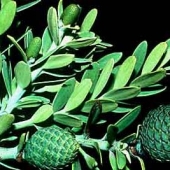Please select root levels for the menu
NZ Plants
Dacrydium cupressinum - rimu, red pine
Podocarp family: Podocarpaceae
-
Mature foliage
L Jensen
View picture -
Mature foliage, leaf arrangement
L Jensen
View picture -
Mature foliage, leaves
L Jensen
View picture -
Mature foliage, leaves with stomata
L Jensen
View picture -
Bark
L Jensen
View picture -
Juvenile foliage
L Jensen
View picture -
Juvenile foliage with spreading leaves
L Jensen
View picture -
Branches bearing pollen cones
L Jensen
View picture -
Pollen cone
L Jensen
View picture -
Pollen cone scales
L Jensen
View picture -
Ovule cone at time of pollination, fertile scale with ovule
L Jensen
View picture -
Ovule at time of pollination, basal view. The ovule with pore (micropyle) is enclosed by the epimatium.
L Jensen
View picture -
Young seed cone. Growth of the ovule (reddish) has projected it beyond the epimatium cup (pale green).
L Jensen
View picture -
Mature seed cone. The epimatium cup has turned red and the subtending bracts have become fleshy and coloured.
L Jensen
View picture
Dacrydium cupressinum is a large forest tree with close set and pointed scale leaves. Branches on adults have short, weeping branchlets while those on juveniles have longer and more strongly weeping branches. The ovule cone consists of a single fertile scale and a single ovule protected by a cluster of sterile bracts below. The young ovule is surrounded by an integument which in turn is covered by an epimatium (derived from the seed scale). The developing seed outgrows the epimatium so that at maturity, it projects beyond a reddish eipmatium cup. The sterile bracts below become fleshy and bright orange to red.
An endemic species found throughout New Zealand.
A small genus with one species in New Zealand and 15-20 species distributed around Southeast Asia and southern China.
Vegetative characteristics |
Reproductive characteristics |
|---|---|
Adult plant form: tree 30- 50 m with short weeping branches |
Pollen and ovule cones: on separate trees |
Adult leaf form: linear, awl-shaped (concave inner surface) slightly angled away from the stem |
Pollen cone: 5-10 mm long with 30-40 scales |
Adult leaf size: 2-3 mm long |
Ovule cone: 60-120 mm long with several bracts, one bearing a fertile cone scale with a single ovule |
Adult leaf arrangement: overlapping, spiral, flattened to the stem for part of their length |
Ovule cone position: terminal, on upward bending stem tip |
Juvenile plant form: long, strongly weeping branches |
Ovule covering: an inner covering (integument); an outer covering (epimatium) sheathes only the base of the ovule |
Juvenile leaf form: linear, awl-shaped, sharply angled away from the stem |
Ovule pore (micropyle): inclined at pollination, becoming upright as seed matures |
Juvenile leaf size: 4-7 x 0.5-1 mm |
Mature seed cone: fleshy, up to 7mm long; one seed |
Juvenile leaf arrangement: spiral, spreading |
Stem below seed (receptacle): fleshy, derived from basal bracts; red |




